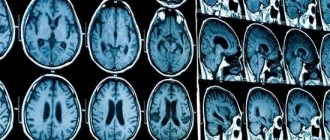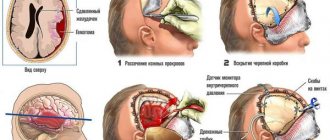Neurology
- a section in modern medicine dealing with the study of diseases of the nervous system - central and peripheral. A neurologist diagnoses and treats diseases of the nervous system, and also prescribes preventive treatment.
The structure of the human nervous system includes:
- Brain
- Spinal cord
- Nerve bundles
- Nerve plexuses
- Nerve endings and fibers
The entire system consists of nerve cells called neurons. If the functioning of neurons begins to malfunction, then inflammation occurs in the central nervous system (CNS), which can lead to serious problems for the entire body as a whole.
What does a neurologist treat?
The list of diseases of the nervous system is quite wide and varied. Most often, these diseases are based on the following reasons:
The most common reason for visiting a neurologist is headaches.
, and in particular,
migraine
. This disease is characterized by severe pain in the temporal lobe of the head. You can also consult a neurologist with the following diseases or symptoms:
Unfortunately, this is not the entire list of diseases and symptoms, but only common ailments for which people consult a neurologist.
Other types of head pain:
- Aching pain in the head. Monotonous, compressive, spreads throughout the head, often involving the temples. It occurs most often - it affects up to 60% of people.
- “Cervical” head pain of medium intensity, spreads from the base of the neck to the back of the head, affecting the temples and eyes. The pain may be accompanied by dizziness, muscle pain in the cervical spine.
- All-encompassing pain in the head is characterized by a feeling of heaviness and fullness from the inside, spreading to the entire head. Intensifies with changes in atmospheric pressure and alcohol consumption.
- Tension pain is characterized by the appearance in the evening of a dull, monotonous pain throughout the head. This condition can last for several hours.
- A dull aching pain in the head appears in the middle of the day or after physical activity, for example when climbing stairs, and is accompanied by the appearance of black “spots” in front of the eyes, weakness, dizziness, and blood rushes to the head.
- Dull pain in the head that occurs in the morning.
What symptoms should you consult a neurologist for?
It is important to know that disturbances in the functioning of the central nervous system occur slowly and imperceptibly. For this reason, many people are not even aware of the serious danger of developing a particular disease, for example paralysis, psychosis or deterioration of intelligence. In older people, the risk of developing various diseases associated with the nervous system increases significantly.
If you notice one of the following symptoms, immediately contact a neurologist:
To avoid various types of diseases of the nervous system, you need to lead a healthy lifestyle and follow basic rules:
Headache causes, methods of diagnosis and treatment
The following types of headaches are distinguished:
Migraine
Severe throbbing pain, causing nausea, intolerance to strong odors and bright light. It is accompanied by general weakness and worsens with minimal physical activity. The duration of the pain attack is from 4 hours to 3 days. Migraines most often occur in people between 20 and 40 years of age. It is not life-threatening, but it causes serious discomfort to a person.
Tension type pain
The most common type of headache. It is often not severe, but can regularly bother a person and last up to 7 days. The nature of the pain is squeezing or pressing. Spreads to the forehead, crown and back of the head. This type of pain syndrome occurs in people who spend a long time in a sitting position or are exposed to strong psycho-emotional stress.
Horton's headache
One of the most severe and dangerous types of pain. Characterized by prolonged pulsating attacks. The pain occurs in the eye or forehead area and causes redness, tears and swelling. Headache attacks can last from 30 minutes to 1.5 hours. Mostly occurs in middle-aged men.
Headache caused by infections
Such pain is accompanied by fever and chills. With acute respiratory infections and flu, pain is localized in the frontal or temporal parts. If the pain syndrome is caused by bacterial diseases, then it is accompanied by various neurological symptoms.
Sinus headache
This type of pain occurs due to inflammation in the sinuses. It is accompanied by a runny nose and swelling of the mucous membrane. Painful sensations are localized in the paranasal and frontal parts. They can bother a person until the underlying disease is cured.
Headache with increased intracranial pressure
Severe pain, accompanied by intolerance to bright light and nausea. They spread over the entire surface of the head and can reach the area around the eyes. This type of pain is observed in people after birth injuries and in those who have suffered traumatic brain injuries.
Trigeminal nerve headache
An attack of such pain lasts a few seconds, but is characterized by a painful course. It may occur while talking or eating. Damage to the trigeminal nerve develops against the background of stomatitis, sinusitis, caries and malocclusion.
Diagnosis of diseases of the nervous system
Diagnosis of diseases of the nervous system involves a neurological examination of the patient, during which his consciousness, orientation in space, intelligence, sensitivity, reflexes, etc. are analyzed. Sometimes a neurological disease can be identified based on clinical indicators, but most often it is necessary to resort to various medical studies:
and MRI (magnetic resonance imaging) can identify neoplasms, hemorrhage and other foci of disease in the patient’s body.
and ultrasound examination allow to identify vascular disorders in the human body
, radiography and electroencephalography allow diagnosing diseases of the nervous system
and
blood tests
.
Make an appointment with a neurologist
Make an appointment
What does the doctor specialize in?
A vascular surgeon is a specialist in the field of angiology and phlebology, a doctor involved in diagnostics, selection of the optimal method of therapy in the treatment of blood vessel pathologies, and prevention of venous diseases. His arsenal includes minimally invasive surgical methods that make it possible to eliminate vascular pathology with a minimum size of incisions. This approach reduces the degree of injury and helps shorten the rehabilitation period.
Main areas of activity of a vascular surgeon
- Diagnosis of pathologies of the great vessels: varicocele, thrombosis, varicose veins, thrombophlebitis, atherosclerosis of the lower extremities, thrombotic lesions of the renal artery.
- Carrying out conservative therapy aimed at eliminating degenerative processes.
- Prevention of arterial and venous diseases in patients at risk.
- Minor and full-fledged surgical operations aimed at eliminating pathology.
- Prosthetics of damaged vessels.
- Observation and treatment of congenital pathologies of blood vessels: arterial or venous malformations, hemangiomas.
- Monitoring of oncological tumors located close to or on great vessels.
A timely visit to a vascular angiosurgeon will help avoid problems in the future. Even if varicose veins have not yet formed, a specialist will also be able to help and select effective preventive measures. The health of your legs and blood vessels is the priority of the angiosurgeon.
Principles of treatment
What does a neurologist do when there is already a diagnosis? Begins to treat the disease using different methods.
Medicines
To relieve acute pain and inflammation, medications are prescribed, and maintenance therapy is provided if necessary. Problems with blood vessels, concussions, epilepsy, and conditions after surgery almost always require medication.
Manual therapy
Manual therapy is a treatment with hands (from the Latin manus - hand), which helps eliminate functional blocks and muscle spasticity, normalize microcirculation and range of motion. Widely used for diseases of the joints and spine, neuroses.
Massotherapy
One of the most effective methods of treating neurological diseases, along with therapeutic exercises and physiotherapy. Using special techniques, the specialist gently influences the patient’s body to stimulate the body’s natural recovery processes.
Physiotherapy
Through physical techniques, it is possible to accelerate tissue regeneration processes, improve nerve conduction, thereby reducing the intensity of pain and inflammation.
Reflexology
The essence of the method is the impact on bioactive points to restore the disturbed balance. It is based on the idea of the body as an integral system, when one of its elements fails, others suffer.
Traction traction
Used to stretch limbs and muscles in case of bone fractures and diseases of the spine.
Kinesitherapy
“Movement treatment” is how this term is translated from scientific language. This is a type of physical therapy that combines medical, physiological, and biochemical aspects.
Osteopathy
This is a method similar in effectiveness to massage and manual techniques. But, unlike them, it affects the very cause of the disease, helping to restore the well-coordinated functioning of the body.
Therapeutic blockades
For severe pain that cannot be relieved with conventional medications, the sore spot is injected. Injections are made directly into the painful area, hitting the nerve endings. The procedure relieves a person from pain in a matter of minutes for a period of half an hour to several days.
Summing up
The fight against vascular pathologies is a complex of measures of conservative therapy and surgical intervention. The choice of treatment regimen is based on the results of diagnosing the condition of the blood vessels. Having assessed the course of the disease, stage of development and form, causes and consequences, the vascular surgeon prescribes medications, physical therapy, can adjust the patient’s diet and diet, recommend compression stockings, prescribe a minimally invasive procedure, or issue a referral to a hospital. The specialist also takes into account possible contraindications and health restrictions, concomitant chronic diseases.
Timely diagnosis and treatment of blood vessels is the key to health and longevity.










